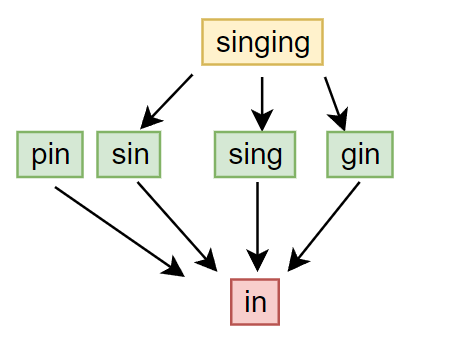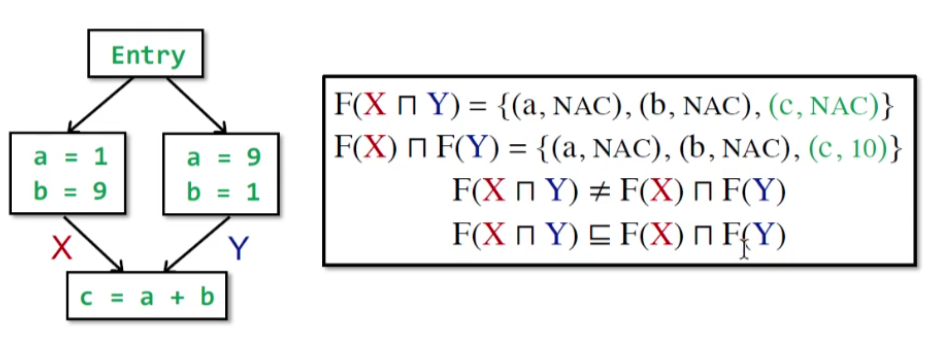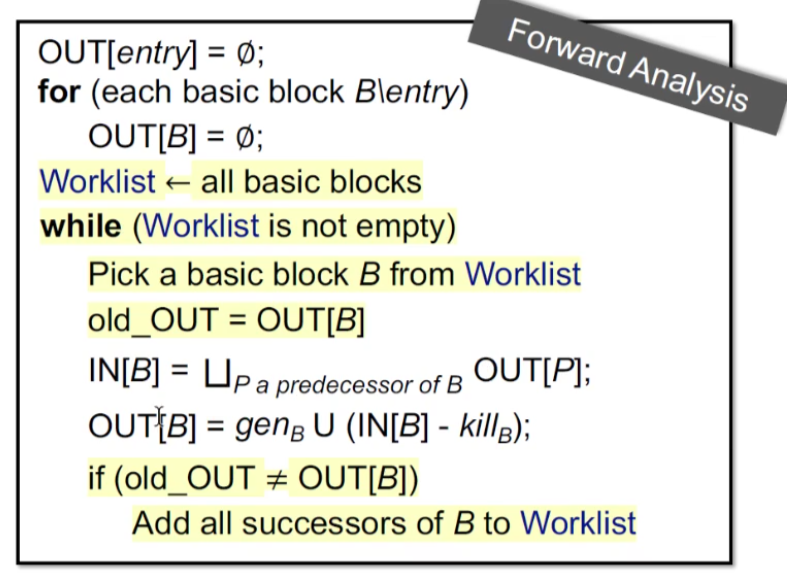static_program_analysis_04_data_flow_analysis_foundations
Data Flow Analysis – Foundations
Contents
-
Iterative Algorithm, another view
-
Partial Order
-
Upper and Lower Bounds
-
Lattice, Semilattice, Complete and Product Lattice
-
Data Flow Analysis Framework via Lattice
-
Monotonicity and Fixed Point Theorem
-
Relate Iterative Algorithm to Fixed Point Theorem
-
May/Must Analysis, A Lattice View
-
Distributivity and MOP
-
Constant Propagation
-
Worklist Algorithm
涉及到:数学理论和证明,内容概念抽象而繁杂。
Iterative algorithm
This general iterative algorithm produces a soluiton to data flow analysis.
For May&Forward Analysis
- OUT[entry] = ∅
- OUT[B]=∅
- $OUT[B] = IN[B]=∪_{P \space a \space predecessor \space of \space B}OUT[P], \space gen_B \space ∪ \space (IN[B] - kill_B) $

这是上一节课所总结的内容,现在从另一个角度来分析;
View Iterative Algorithm in Another Way
-
Given a CFG(program) with k nodes, the iterative alogrithm updates OUT[n] for every node n in each iteration
-
Assume the domain of the values in data flow analysis is V, then we can define a k-tuple.
$$
(OUT[n_1], OUT[n_2], … ,OUT[n_k])
$$
as an element of set ($V_1 × V_2 × …×V_k$) denoted as $V^k$, to hold the values of the analysis after each iteration. -
Each iteration can be considered as taking an action to map an elemtn of $V^k$ to a new element of $V^k$, through applying the transfer functions and control-flow handing, abstracted as a function $F:Vk$->$Vk$
-
Then the algorithm outputs a series of k-tuples is the same as the last one in two consecutive iterations.
Sample

可以看到:
-
红色部分的代码可以视为初始化的过程;
init=> (⊥, ⊥, …, ⊥) = $X_0$(⊥, ⊥, …, ⊥)是一个k-tuple,用bottom表示其元素;
-
黄色部分的代码作为迭代的条件
when
iter i=> (${v_1}i,{v_2}i,…,{v_k}^i$) = $F(X_{i-1})$exists
iter i+1=> (${v_1}{i},{v_2}{i},…,{v_k}^{i}$) = $F(X_i)$即:
$X_i = X_{i+1}$ => $X_i=X_{i+1}=F(X_i)$
则达到不动点,退出循环;
-
绿色部分的代码迭代的操作
iter 1=> (${v_1}1,{v_2}1,…,{v_k}^1$) = $X_1$ = $F(X_0)$iter 2=> (${v_1}2,{v_2}2,…,{v_k}^2$) = $X_2$ = $F(X_1)$…
iter i=> (${v_1}i,{v_2}i,…,{v_k}^i$) = $X_i$ = $F(X_{i-1})$
由此得到的结论是:
$X$ is a fixed point of function $F$ if $X=F(X)$ => The iterative algorithm reaches a fixed point.
partial means for a pair of set elements in P, they could be incomparable; in other words, not necessary that every pair of set elements must statisfy the ordering $\sqsubseteq$. 不一定所有元素都需要满足.
Some Question
The iterative alogrithm (or the IN/OUT equation system) produces a solution to a data flow analysis
-
Is the algorithm guaranteed to terminate orreach the fixed point, or does it always have a soluiton?
所有的data flow的分析都可以使用吗,一定都能达到不动点吗?
-
If so, is there only one solution or only one fixed point? If more than one, is our solution the best one(most precise)?
如果不动点成立,它只有一个吗,是最精确的吗?
-
When will the algorithm reach the fixed point, or when can we get the solution?
什么时候能到不动点?
Partial Order
偏序集poset(PartiallyOrdered set), We define poset as a pair(P, $\sqsubseteq$) where $\sqsubseteq$ is a binary relation that defines a partial ordering over P, and $\sqsubseteq$ has the following properties:
(1) Reflexivity自反性: $\forall x \in P, x \sqsubseteq x$
(2) Antisymmetry反对称性$\forall x,y \in P,x \sqsubseteq y \land y \sqsubseteq x $ => $x=y$
(3) Transitivity传递性$\forall x,y,z \in P, x \sqsubseteq y \land y \sqsubseteq z$ => $x \sqsubseteq z$
满足这三个性质的set为poset
Sample 1
Is ($S, \sqsubseteq$) a poset where S is a set of integers and $\sqsubseteq$ representes $\leq$ (less than or equal to)?
当S是整数集合时,S是poset吗?
(1) Reflexivity: 1 <= 1, 2 <= 2
(2) Antisymmetry: 1 <= 1 $\land$ 1 <= 1 then 1 = 1
(3) Transitivity: 1 <= 2 $\land$ 2 <= 3 then 1 <= 3
因此$S$为opset;
Sample 2
Is ($S, \sqsubseteq$) a poset where S is a set of integers and $\sqsubseteq$ representes $<$ (less than)?
当S是整数集合时,S是poset吗?
(1) Reflexivity: 1 < 1, 2 < 2 ----不满足
Sample 3
Is ($S, \sqsubseteq$) a poset where S is a set of English words and $\sqsubseteq$ representes the substring relation, i.e., $s1\sqsubseteq s2$ means s1 is a substring of s2?
当S是满足上述条件的英文单词集合,S是opset吗?
S such as :

(1) Reflexivity: 每个string是否为自己的substring?符合
(2) Antisymmetry: string是自己的substring,反过来还是。符合
(3) Transitivity: in $\in$ sing, sing $\in$ singing => in $\in$ singing 符合
Upper & Lower Bounds
Given a poset(P,$\sqsubseteq$) and its subset S that S $\subseteq$ P, we say that u $\in$ P is an upper bound of S, if $\forall x \in S, x \sqsubseteq u$.Similarly, we say that l $\in$ P is an lower bound of S, if $\forall x \in S, l \sqsubseteq x$.
Sample 1

对于S:
upper bound => {a, b, c}
lower bound => {}
We define the
least upper bound 最小上界(lub or join) of S, written $\sqcup$S, if for every upper bound of S, say u, $\sqcup$S $\sqsubseteq$ u. Similarly, We define thegreatest lower bound 最大下界(glb or meet) of S, written $\sqcap$S, if for every upper bound of S, say l, l $\sqsubseteq$ $\sqcap$S.
Sample 2

对于S:
upper bound => {a, b, c}, {a, b}
least upper bound (join or lub,) => {a, b}
lower bound => {}
greast lower bound (meet or glb, ) => {}
Properties
-
Not every poset has
luborglb -
But if a poset has lub or glb, it will be unique
Proof.
assume $g_1$ and $g_2$ are both glbs of poset P according to the definition of glb
$$
g_1 \sqsubseteq (g_2 = \sqcap P) ,\space g_2 \sqsubseteq(g_1 = \sqcap P)
$$
by theantisymetryof partiallyordered set => $\sqsubseteq g_1=g_2$
Lattice
Given a poset(P, $\sqsubseteq$), $\forall a, b \in P, if \space a \sqcup b$ and $a \sqcap b$ exists, then (P, $\sqsubseteq$) is called a lattice.
A poset is a lattice if every pair of its elements has a least upper bound and ag reatest lower bound.
Sample 1
Is(S, $\sqsubseteq$) a lattice where S is a set of integers and $\sqsubseteq$ represents <= (less than or equal to)?
The $\sqcap$ operator means “min”, The $\sqcup$ operator means “max”. so yes.
Sample 2
Is ($S, \sqsubseteq$) a lattice where S is a set of English words and $\sqsubseteq$ representes the substring relation, i.e., $s1\sqsubseteq s2$ means s1 is a substring of s2?

必须要满足任意元素的最小上界和最大下界都存在,但是pin和sin显然没有共同的最小上界。 so no.
Sample 3

The $\sqcap$ operator means $\cap$, The $\sqcup$ operator means $\cup$. so yes.
Semilattice
Given a poset(P, $\sqsubseteq$), $\forall a, b \in P$,
if only $a \sqcup b$ exists, then (P, $\sqsubseteq$) is called a join semilattice.
if only $a \sqcap b$ exists, then (P, $\sqsubseteq$) is called a meet semilattice.
Complete Lattice
Given a lattice(P, $\sqsubseteq$), for arbitrary subset S of P, if $\sqcup S$ and $\sqcap S$ exist, then (P, $\sqsubseteq$) is call a complete lattice.
All subsets of a lattice have a least upper bound and a greatest lower bound.
Sample 1
Is(S, $\sqsubseteq$) a complete lattice where S is a set of integers and $\sqsubseteq$ represents <= (less than or equal to)?
For a subset $S^+$ including all positive integers, it has no $\sqcup S^+$($+\infty$)
整数集本身是无穷的,无边界的。
Sample 2

Yes. The definition of bounds implies that the bounds are not necessarily in the subsets(but they must be in the lattice)
Top & Bottom
Every complete lattice (P, $\sqsubseteq$) has
a greatest element T = $\sqcup P$ called top
a least elemtent ⊥ = $\sqcap P$ called bottom
Every finite lattice (P is finite) is a complete lattice. 有穷格是完全格,但是完全格不一定是有穷格(0,1之间的实数集)。
Product Lattice
Given lattices $L_1=(P_1, \sqsubseteq_1),L_2=(P_2,\sqsubseteq_2),…,L_n=(P_n,\sqsubseteq_n)$, if for all i, $(P_i, \sqsubseteq_i)$has $\sqcup_i$(least upper bound) and $\sqcap_i$(greatest lower bound), then we can have a
product lattice$L^n = (P, \sqsubseteq)$ that is defined by:
- 值域:$ P = P_1 × P_2 × \space … \space × P_n$
- two element to opset:$(x_1, \space … \space x_n ) \sqsubseteq (y_1, \space … \space y_n)$ <=> $(x_1 \sqsubseteq y_1) \and … \and (x_n \sqsubseteq y_n)$
- 下界关系:$(x_1, \space … \space x_n ) \sqcup (y_1, \space … \space y_n)$ = $(x_1 \sqcup_1 y_1, … , (x_n \sqcup_n y_n)$
- 上界关系:$(x_1, \space … \space x_n ) \sqcap (y_1, \space … \space y_n)$ = $(x_1 \sqcap_1 y1 , … , (x_n \sqcap_n y_n)$
A product lattice is a lattice
If a product lattice L is a product of complete lattices, then L is also complete
Data Flow Analysis Framework via Lattice
A data flow analysis framework (D, L, F) consists of:
- D:a
directionof data flow: forwards or backwards- L:a
latticeincluding domain of the values V and a meet $\sqcap$ or join $\sqcup$ operator- F:a family of
transfer funcitonsfrom V to V
Sample

对于如上的例子,先看左边,
-
假设已知:
-
Direction: Forward
-
Merge: Union
-
OUT[s1]={a}, OUT[s3]={b}
可以得到:
- IN[s2]={a,b};
-
那么以上操作对应右侧,有:
- May Analysis从bottom开始:
- 初始化空{},对应a,b,c的subset为{0,0,0};
- OUT[s1],OUT[s3]得到的IN[S2]={a,b},是一个向上汇聚的过程
而由IN到OUT需要做一个F: tansfer function操作;
Data flow analysis can be seen as iteratively applying transfer functions and meet/join operations on the values of a lattice
Review the questions
-
Is the algorithm guaranteed to terminate orreach the fixed point, or does it always have a soluiton?
所有的data flow的分析都可以使用吗,一定都能达到不动点吗?
- Recall “OUT never shrinks” It is about monotonicity. Lattice上的单调性问题。
- 关联问题?Now what we have just seen is the property(fixed point theorem) for the function on a lattice. We cannot say our iterative algorithm also has that property unless we can relate the algorithm to the fixed point theorem, if possible.
-
If so, is there only one solution or only one fixed point? If more than one, is our solution the best one(most precise)?
如果不动点成立,它只有一个吗,是最精确的吗?
- 对于$X=F(X)$的函数不动点,一个函数可以有多个不动点。还有一个问题待解决。Iterative algorithm 从初始化开始递归,需要走到哪一个不动点?哪一个精确呢?
-
When will the algorithm reach the fixed point, or when can we get the solution?
什么时候能到不动点?
Monotonicity
A function f: L -> L (L is a lattice) is monotonic if $\forall x, y \in L, x \sqsubseteq y$ => $f(x) \sqsubseteq f(y)$
Fixed-Point Theorem
Given a complete lattice(L, $\sqsubseteq$), if:
f: L -> L is monotonic & L is finite,
前提是:全格 + 单调 + 有限
then,
the least fixed point of f can be found by iterating
- $f(⊥), f(f(⊥)), … ,f^k(⊥)$ until a fixed point is reached
单调 + 由⊥迭代 => 最小不动点
the greastest fixed point of f can be found by iterating
- $f($T$)$, $f(f($T$))$, … ,$f^k($T$)$ until a fixed point is reached
单调 + 由T迭代 => 最大不动点
若要证明最小不动点成立,需要证明:
- 不动点存在
- 不动点最小
若要证明最大不动点成立,需要证明:
- 不动点存在
- 不动点最大
Existence of Fixed Point
如何证明不动点的存在?
Proofs.
Bt the definition of ⊥ and f: L -> L, we have
$$
⊥ \sqsubseteq f(⊥),\space f(⊥) \in L
$$
As f is monotonic, we have
$$
f(⊥) \sqsubseteq f(f(⊥)) = f^2(⊥),\space f(⊥) \sqsubseteq f^2(⊥)
$$$$
f(⊥) \in L, \space f^2(⊥) \in L
$$Similarly (by repeatedly applying f), we have
$$
⊥ \sqsubseteq f(⊥) \sqsubseteq f^2(⊥) \sqsubseteq … \sqsubseteq f^i(⊥)
$$
As L is finite, for some k, we have
$$
f^{Fix} = f^k(⊥) = f^{k+1}(⊥)
$$
Thus, the fixed point exists.
Least Fixed Point
证明最小不动点?
Proof.
Assume we have another fixed point x, i.e., x = f(x)
By the definition of ⊥, we have ⊥ $\sqsubseteq $ x
Induction begins:
As f is monotonic, we have
$$
f(⊥) \sqsubseteq f(x)
$$
Assume $f^i(⊥) \sqsubseteq f^i(x)$, as f is monotonic, we have
$$
f^{i+1}(⊥) \sqsubseteq f^{i+1}(x)
$$
Thus by induction, we have
$$
f^i(⊥) \sqsubseteq f^i(x)
$$
Thus $f^i(⊥) \sqsubseteq f^i(x)=x$, then we have
$$
f{Fix}=fk(⊥) \sqsubseteq x
$$
Thus the fied point is the least.
Greatest Fixed Point
参考最小不动点的证明,可以得到:
$$
x \sqsubseteq fk(⊥)=f{Fix}
$$
Relate Iterative Algorithm to Fixed-Point Theorem
如何关联呢?


If a product lattice $L^k$ is a product of complete (and finite) lattices, i.e., (L, L, …, L), then $L^k$ is also complete (and finite)
In each iteration, it is equivalent to think that we apply
function Fwhich consists of
- transfer function f: L -> L for every node <=> 对于每个node应用transfer function
- join/meet function $\sqcap$/$\sqcup$: L × L -> L for control-flow confluence <=> merge时进行处理,应用join或meet
已经证明了是有限的,现在需要证明的是function F是否是单调的。
$Gen, Kill$ function is monotonic => transfer function is monotonic
Is join/meet function monotonic?
To prove join is monotonic =>
Proof.
$\forall x, y, z \in L, \space x \sqsubseteq y$, we want to prove $x \sqcup z \sqsubseteq y \sqcup z$ => 意味着 进行join操作后,仍然满足单调关系
by the definition of $\sqcup, \space y \sqsubseteq y \sqcup z$ => join求的是两个元素的最小上界,所以 y join z 会满足$\space y \sqsubseteq y \sqcup z$
by transitivity of $\sqsubseteq, \space x \sqsubseteq y \sqcup z$ => 由于$x \sqsubseteq y$,根据传递性,可以得到$x \sqsubseteq y \sqsubseteq y \sqcup z$
thus $y \sqcup z$ is an upper bound for x, and also for z (by $\sqcup$'s definition) => $y \sqcup z$为x的上界,y和z的最小上界
as $x \sqcup z$ is the least upper bound of x and z => $x \sqcup z$是x,z的最小上界,最小上界小于$y \sqcup z$(上界)
thus $x \sqcup z \sqsubseteq y \sqcup z$
同理可证meet;
When will the algorithm reach the fixed point?
The height of a lattice $h$ is the length of the longest path from Top to Bottom in the lattice.

对于上图的例子而言,其高度$h=3$;
现在需要求得到不动点需要的迭代次数$i$;

在每次迭代中,假设往一个方向上的每一次迭代只有一个结点的变化,例如0->1。
假设lattice高度为h,而结点个数为k,最坏情况下,相当于每一个结点从空到"满",从bottom->top,每一个结点需要处理h次,则需要的迭代次数为h*k;
May&Must Analysis from a lattice view
通过lattice的角度,用图例说明上述结论。

假设lattice是一个product lattice。
May Analysis
目的是:unsafe result -> safe result
例如,Reaching Definition中:
程序开始时即为bottom,处于unsafe result(No definitions can reach所有变量都初始化了,因为作为一个查询错误的程序,所以如果一开始就表述结果为没有错误,就是一个unsafe的结果)。
当处于safe result(All definitions may reach),即查错程序认为程序的变量都有出现了reach的问题,但这是Safe but useless result。因为作为查错程序,需要找出Truth。
查错程序停留在Truth时,即为所需要求得的result。

假设一个lattice为上图左边部分所示,{a,c}为Truth,那么Truth上即为safe,而Truth下为unsafe。那么如何知道有没有进入到Safe域。
在求解步骤中存在很多不动点,但是may analysis所求的是最小不动点。

处于精确度的考虑,最小不动点与Truth最相近,因此Least Fixed Point在Fixed Points中最为准确。
Must Analysis
目的是:unsafe result -> safe result
以expressions available的优化程序为例,Top的初始为unsafe(All expressions must be available),这就相当于程序还没有开始分析优化,就断定所有expression都available,都可以使用,所以是unsafe。
当运行到bottom时,是safe的,相当于所有expression都是不可用,这是一种safe的情况,但是没有相当于不需要再做优化,因此相当于一个safe but useless result。
因为Must Analysis允许漏报,但是不允许误报。如果处于unsafe域,在expressions availble检查中,如果误报,则程序分析会导致错误。

针对与该分析,must Analysis时,到达最大不动点时,进入safe域,最接近truth,因此最为精确。

How Precise is our solution?
-
Meet-Over-All-Paths Solution (MOP)
A path P from Entry to S:
P = Entry -> S1 -> S2 -> … -> Si ;
$F_P$作为transfer function,对每一个Statement,得出一个OUT,作为下一个statement的IN;
MOP理解起来就是,把多条所有Path的结果join/meet => $MOP[S_i]= \sqcup /\sqcap $
$F_P(OUT[Entry])$
有一些路径不会执行,有一些程序会有循环没有边界,有一些程序路径数量很多,无穷枚举,这些结果不应该被join/meet;
举一个例子:OUR Iterative Alogrithm vs. MOP

上图是Iterative Alogrithm的做法,merge时join后在使用transfer function处理;
而对于MOP,可以得到
$MOP[S_4]=f_{S_3}(f_{S_1}(OUT[Entry])) \sqcup f_{S_3}(f_{S_2}(OUT[Entry]))$
相当于merge时,先transfer function处理各个分支,再join;
即表示为:
$$
Ours=F(x \sqcup y)
$$$$
MOP=F(x)\sqcup F(y)
$$他们之间的关系是什么?

得到$MOP \sqsubseteq Ours$;
当F is distributive,F具有分配性,$F(x \sqcup y)=F(x) \sqcup F(y)$,则有$MOP=Ours$
对于bit-vector or Gen/kill problems,Ours 几乎和MOP一样准;
一个例子:
[Constant Propagation]
Given a variable x at program point p, determine whether x is guaranteed to hold a constant value at p. – must analysis
-
The OUT of each node in CFG, includes a set of pairs (x,v) where x is a variable and v is the value held by x after that node.
A data flow analysis framework(D, L, F)consits of:
- D: a direction of data flow => [fowards]
- L: a lattice including domain of the values V and a meet or join operator
- F: a family of transfer functions from V to V
-
Lattice
-
Domain of the values V

UNDEF: undefined
NAC: not a constant
-
Meet Operator
NAC $\sqcap$ v = NAC
UNDEF $\sqcap$ v = v
c $\sqcap$ v = ?
- c $\sqcap$ c = c
- c1 $\sqcap$ c2 = NAC
-
-
transfer function

-
Nondistributivity
一个例子:

-
Worklist Alogrithm, an optimization of Iterative Algorithm
Iterative Algorithm在OUT没有变化时才会停止迭代,而worklist algorithm则相反,只处理那些OUT变化的node;

对于Forward Analysis而言,将所有的bb放到worklist中,只要worklist不是空的,则选择一个worklist中的bb来进行transfer操作,如果操作后OUT变化了,则说明后面的bb的IN可能变化了,则将其所有后继加入到worklist中。
Summary
- Iterative Algorithm, another view
- partial order
- upper and lower bounds
- lattice, semilattice, complete and product lattice
- data flow analysis framework via lattice
- monotonicity and fixed point theorem
- relate iterative algorithm to fixed point theorem
- may/must analysis, a lattice view
- MOP and distributivity
- constant propagation
- worklist algorithm
Key Point
- Understand the functional view of iterative algorithm
- The definitions of lattice and complete lattice
- understand the fixed-point therorem
- how to summarize may and must analysis in lattices
- The relation between MOP and the solution produced by the iterative algorithm
- Constant propagation algorithm
- Worklist algorithm
